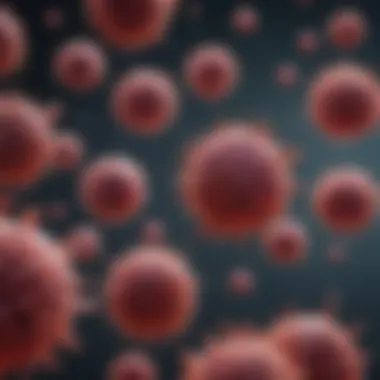Exploring Immune System Cells: Structure and Function


Intro
The immune system is a complex network of cells and molecules that protects the body from pathogens and diseases. Understanding immune system cells is crucial for appreciating how our body functions to maintain health. Each cell type plays a distinct role, contributing to a robust defense mechanism. In this article, we will explore the structure and function of various immune cells, how they interact, and their implications in both health and disease. Recent advancements in research provide insights into how these cells can be targeted for therapeutic purposes and enhance our comprehension of immune response mechanisms.
Recent Advances
Latest Discoveries
Recent studies have unveiled new insights into the functioning of immune system cells, particularly in the context of chronic diseases. For instance, researchers have identified specific subtypes of T cells that exhibit unique properties in autoimmune conditions. This discovery highlights that not all T cells function the same way, and subtle differences can have significant implications for treatment approaches.
Another impactful finding involves memory B cells. These cells are pivotal in establishing long-lasting immunity after infections or vaccinations. Understanding their lifecycle and activation patterns could lead to improved vaccination strategies and better management of infectious diseases.
Technological Innovations
Advancements in technology have dramatically enhanced our ability to study immune cells. High-throughput sequencing and single-cell analysis are now commonplace. These methods allow scientists to explore the genomic and transcriptomic landscapes of immune cells in unprecedented detail. This leads to a more nuanced understanding of how cellular interactions drive immune responses.
Moreover, imaging techniques like multiphoton microscopy enable real-time observation of immune cell behavior within living tissues. Such innovations are vital for uncovering the dynamics of immune responses, and their role in both pathogen defense and disease pathology.
Implications of Immune Cells in Health and Disease
Understanding immune cells leads us to appreciate their dual role in health and disease. For one, they protect against infections; for another, when dysregulated, they can contribute to inflammatory and autoimmune diseases. This duality reinforces the importance of studying immune system cells comprehensively.
- Infections: Immune cells target and eliminate pathogens. The efficiency of this response influences recovery outcomes.
- Autoimmunity: Dysregulation can lead to autoimmune diseases like rheumatoid arthritis and lupus. Specific immune cells mistakenly attack healthy tissues, leading to chronic inflammation.
- Cancer: Tumors can manipulate immune responses to evade detection. Research is focusing on how to harness immune cells in immunotherapy to attack cancer cells more effectively.
"Recent research shows the potential of reprogramming immune cells to enhance their ability to target cancer more effectively."
Epilogue
The exploration of immune system cells reveals a landscape rich in complexity and significance. As we continue to uncover the intricacies of these cells, our understanding of their roles in health and disease deepens. Moreover, the ongoing advancements in research and technology are set to pave the way for new therapeutic strategies that leverage immune cell functionality. The implications of this research are profound, as they hold the promise of significant improvements in managing various diseases.
Prelims to the Immune System
The immune system serves as the body's primary defense mechanism against pathogens, including viruses, bacteria, and other foreign entities. Understanding the immune system is crucial for grasping how our bodies maintain health and respond to diseases. In this section, we aim to highlight the essential components and functions of the immune system, emphasizing the role of immune cells as the linchpins of this complex network.
Overview of Immune Function
The immune system is composed of a network of cells, tissues, and organs that collaboratively work to protect the body from infectious agents. Two major branches characterize immune function: the innate immune system and the adaptive immune system. The innate immune response is the body's first line of defense. It acts quickly and non-specifically to pathogens, utilizing cells such as macrophages and neutrophils. In contrast, the adaptive immune response is more sophisticated. It involves specific recognition of pathogens and the establishment of a memory that allows for a more rapid response upon subsequent exposures.
Key Functions Include:
- Detection and identification of pathogens
- Elimination of harmful invaders
- Communication with other cells through signaling molecules such as cytokines
- Development of immunological memory for faster responses in future infections
Understanding these functions allows for a deeper appreciation of how immune cells operate and their crucial role in safeguarding health.
Importance of Immune Cells
Immune cells are the fundamental building blocks of the immune response. Each type of cell has a distinct role that contributes to the overall effectiveness of the immune system. Their functions range from recognizing pathogens to executing targeted attacks to help eliminate infections.
Key Immune Cell Types Include:
- Lymphocytes: These include B cells, T cells, and natural killer cells. B cells are responsible for antibody production, while T cells are pivotal in directly attacking infected cells. Natural killer cells provide a rapid response to virally infected cells and tumors.
- Phagocytes: Including macrophages and neutrophils, these cells engulf and digest pathogens, acting as both frontline defenders and initiators of the adaptive immune response.
- Antigen-Presenting Cells: These cells play a crucial role in activating T cells and shaping the adaptive immune response through the presentation of antigens.
The efficiency and precision of the immune response largely depend on the interactions and functions of these immune cells. An understanding of these cells helps illuminate how the immune system operates as a cohesive unit to maintain health and respond to threats.
"The complexity of the immune system lies in the intricate interplay between its various cell types, each with distinct yet complementary roles in promoting resistance to disease."
Types of Immune System Cells
Understanding the types of immune system cells is fundamental for comprehending how the immune system operates. These cells are the frontline defenders against pathogens, playing unique roles that contribute to the overall immunity.
The immune system includes several distinct cell types, including lymphocytes, phagocytes, and antigen-presenting cells. Each type has specific functions and characteristics that aid in recognizing and responding to various threats. This diversity allows for a robust defense mechanism.
Lymphocytes
Lymphocytes are critical components of the adaptive immune response. They include B cells, T cells, and natural killer cells, all of which play pivotal roles in identifying and eliminating pathogens.
B Cells
B cells are well-known for their role in antibody production. These cells recognize antigens and differentiate into plasma cells, which secrete antibodies that specifically target pathogens. A key characteristic of B cells is their ability to create memory cells after an infection, providing long-term immunity.
B cells are essential in vaccine effectiveness, which makes their role in immunology quite significant. The unique feature of B cells is the formation of antibodies tailored to specific antigens. However, B cells may not respond adequately without T cell help, highlighting a limitation in their functionality.
T Cells


T cells are central to cell-mediated immunity. They can be categorized into several types, primarily helper T cells, which assist other immune cells, and cytotoxic T cells, which kill infected cells. The key characteristic of T cells is their specificity; they recognize and respond to particular antigens presented by other cells.
T cells play a crucial role in organizing immune responses and eradicating infections. A unique aspect of T cells is their clonal selection and expansion upon activation, allowing for a swift and targeted immune attack. However, their dependence on antigen-presenting cells for activation can be seen as a drawback in rapid immune responses.
Natural Killer Cells
Natural Killer (NK) cells are unique in their ability to recognize and destroy compromised cells, such as those infected by viruses or transformed by cancer. They do this without prior sensitization to specific antigens, which sets them apart from B and T cells. The rapid response capability of NK cells is a significant advantage, as they provide an immediate defense.
The defining feature of NK cells is their ability to distinguish between healthy and abnormal cells by monitoring molecular signals. However, their innate capacity for killing could lead to tissue damage if not properly regulated.
Phagocytes
Phagocytes, including macrophages, neutrophils, and dendritic cells, are vital in the innate immune response. They are primarily responsible for engulfing and digesting pathogens and cellular debris, thus maintaining health and preventing infection.
Macrophages
Macrophages are large phagocytic cells found throughout the body. Their function extends beyond pathogen destruction; they play a role in activating T cells and orchestrating immune responses. The ability of macrophages to display antigens for recognition by T cells makes them essential for bridging the innate and adaptive immune systems.
Macrophages are also known for secreting cytokines that modulate inflammation. However, the diverse functions of macrophages can lead to complications, as they may contribute to chronic inflammation if dysregulated.
Neutrophils
Neutrophils are the most abundant type of white blood cell and act swiftly during the early stages of infection. They excel in phagocytosis and are known for producing chemicals that kill bacteria. Their rapid response is pivotal during acute inflammatory responses.
A critical characteristic of neutrophils is their short lifespan, typically lasting only a few days. This means they must be replenished constantly during infection. Their unique feature includes the formation of neutrophil extracellular traps (NETs), which help capture pathogens, although this can also lead to tissue damage in some cases.
Dendritic Cells
Dendritic cells serve as professional antigen-presenting cells and are key players in the initiation of immune responses. They capture antigens in peripheral tissues and migrate to lymph nodes to present them to T cells. The ability of dendritic cells to activate naive T cells is crucial for the adaptive immune response.
Their unique feature is the ability to process and present antigens in a way that ensures a robust T cell response. However, their activation and maturation require a delicate balance, as improper signaling can lead to ineffective immune responses.
Antigen-Presenting Cells
Antigen-presenting cells (APCs) are essential for the activation of T cells. They detect, process, and present antigens, enabling the adaptive immune system to respond accurately to pathogens.
Role in Immune Activation
The critical role of APCs in immune activation cannot be overstated. By presenting antigens to T cells, they provide the necessary co-stimulatory signals required for T cell activation. This interaction is crucial in determining the nature of the immune response, whether it is an inflammatory response or one that leads to tolerance.
APCs are characterized by their ability to capture and present antigens from a variety of sources, including infectious agents and cancerous cells. Their unique advantage lies in the complexity of the responses they can elicit, fostering a multifaceted immune defense. However, the intricacies of their activation can sometimes lead to immune dysregulation if not carefully managed.
Cellular Mechanisms of Immunity
Understanding the cellular mechanisms of immunity is crucial for comprehending how the immune system maintains health and combats disease. These mechanisms center around the interactions and functions of immune cells that recognize and respond to pathogens. They are fundamental to disease prevention and recovery, highlighting the importance of targeted therapies and interventions. This section will explore pathogen recognition, activation pathways, and cytokine signaling, offering insights into the robust nature of immune responses.
Recognition of Pathogens
Receptors and Antigens
The recognition of pathogens is primarily facilitated by receptors on immune cells. These receptors, such as T cell receptors (TCRs) and B cell receptors (BCRs), are essential for identifying foreign antigens. Each receptor is highly specific, potentially recognizing unique molecular structures on pathogens like viruses and bacteria. This specificity is a key characteristic, enabling the immune system to target various threats effectively.
Antigens, which are molecules that provoke an immune response, can be whole proteins or fragments of pathogens. Their ability to bind specifically to receptors is what supports the initiation of an immune response. The engagement leads to the activation of immune cells, which is beneficial in mounting a systematic defense against invading pathogens.
One unique feature of this recognition process lies in its adaptability. The receptors can evolve to recognize new pathogens, allowing the immune system to stay effective against emerging diseases. However, this adaptability also poses challenges in autoimmune disorders, where the system may misidentify self-tissues as foreign.
Activation Pathways
The activation pathways are multi-step processes that occur once a pathogen is recognized. These pathways involve signals that lead to the proliferation and differentiation of immune cells. For example, upon binding to an antigen, T cells undergo activation, leading to their division and transformation into effector cells. These effector cells then perform specific functions, such as killing infected cells or helping other immune cells.
Effective activation also involves co-stimulatory signals, further ensuring that only competent immune responses are launched. This process is crucial because it helps prevent unnecessary inflammation that can damage healthy tissues.
Cytokine Signaling
Roles and Functions
Cytokine signaling plays a vital role in the immune response by facilitating communication between immune cells. Cytokines are small proteins released by cells that affect the behavior of other cells. They can inform cells about changes in their environment and direct them to proliferate, differentiate, or migrate toward sites of infection or inflammation.
One key characteristic of cytokines is their ability to create a localized immune response. They act as messengers, ensuring that immune cells can coordinate their responses to pathogens efficiently. This is especially important in maintaining a balance; too much signaling can lead to hyperactive immune responses, contributing to tissue damage, while too little can fail to combat infections effectively.
The unique feature of cytokine signaling is its complexity, involving several different types of cytokines with various functions. This complexity offers a significant advantage, as it enables the immune system to mount tailored responses to different challenges. However, it can also complicate therapeutic strategies targeting specific pathways, due to the risk of unintended consequences on the immune balance.
"Cytokine signaling is a double-edged sword; it can enhance defense against pathogens but may also lead to inflammation if uncontrolled."


In summary, the cellular mechanisms of immunity are intricate and pivotal to understanding immune function in health and disease. The processes of recognition, activation, and communication ultimately determine how effectively the immune system can respond to threats.
Interactions Between Immune Cells
Interactions between immune cells are crucial for a robust immune response. These interactions ensure that immune cells act in a coordinated manner against pathogens. They facilitate communication, enhance cellular functions, and ultimately shape the immune response. Understanding these interactions is vital for insights into how the immune system protects the body and manages diseases.
Cellular Communication
Cellular communication in the immune system involves intricate signaling mechanisms. This signaling ensures that immune cells can respond quickly and effectively to infection or damage.
Cytokines and Chemokines
Cytokines are secreted proteins that mediate and regulate immunity, inflammation, and hematopoiesis. Chemokines are a subset of cytokines that specifically direct cell migration.
The main characteristic of cytokines and chemokines is their ability to influence various immune responses. They help other immune cells, such as T cells and B cells, to proliferate or differentiate. This aspect makes them critical players in the immune system. Their role in inflammation can be beneficial for localizing and eliminating pathogens. However, an excessive production of these signaling molecules can lead to tissue damage, contributing to chronic diseases.
One unique feature of cytokines and chemokines is their specificity. For example, Interleukin-6 (IL-6) plays an important role in amplifying the immune response against infections. In contrast, Tumor Necrosis Factor-alpha (TNF-alpha) can trigger inflammation. Their distinct effects make them ideal for understanding the immune cell interactions outlined in this article.
Cooperation in Immunity
Cooperation among immune cells ensures that multiple types of immune responses work in harmony. For instance, T helper cells often assist B cells in producing antibodies, while cytotoxic T cells directly eliminate infected cells. This cooperation enhances the effectiveness of the immune response.
The synergy between different immune cell types can vastly improve outcomes in immune-related conditions. A deeper understanding of these interactions helps in designing better immunotherapies and treatments for diseases. Overall, the cooperation observed in the immune system is a powerful demonstration of biological integration, vital for maintaining health.
The Role of Immune Cells in Diseases
The immune system plays a pivotal role in maintaining health, defending the body against various pathogens. However, when immune cells malfunction or respond inappropriately, they can contribute to a range of diseases. Understanding how immune cells function in pathological processes is paramount for improving therapeutic strategies and preventive measures. Here, we explore how immune cells contribute to autoimmune disorders, cancer, and infectious diseases.
Autoimmune Disorders
Autoimmune disorders arise when the immune system mistakenly identifies healthy cells as foreign entities. This misidentification leads to an overactive immune response, which damages body tissues. Some common autoimmune diseases include rheumatoid arthritis, lupus, and multiple sclerosis.
Immune cells, particularly T cells and B cells, play a central role in these conditions. T cells can become autoreactive, attacking the body’s tissues. B cells may produce autoantibodies that target normal cells.
"Autoimmune disorders exemplify the delicate balance needed in immune response. The repercussions of immune dysregulation highlight the need for precise therapeutic interventions."
The study of autoimmune diseases emphasizes the complexity of immune regulation. Many factors, including genetics, environmental triggers, and infections, can influence the onset of autoimmune reactions. Research targeting immune modulation holds promise for treating these disorders effectively.
Cancer Immunology
Cancer cells often develop mechanisms to evade detection and destruction by the immune system. Despite this, immune cells are crucial in recognizing and eliminating transformed cells. The relationship between immune cells and cancer is multifaceted and can be characterized by immune evasion, tumor microenvironment, and immunotherapy strategies.
Cytotoxic T lymphocytes are significant effector cells that can directly kill cancer cells. However, they may not always function effectively if the tumor environment suppresses their activity.
Recent advances in cancer immunology have led to therapies such as immune checkpoint inhibitors. These treatments enhance the immune response against cancer by blocking proteins that inhibit T cell activation. Examples are Nivolumab (Opdivo) and Pembrolizumab (Keytruda), which aim to restore immune function in patients with various cancers.
Infectious Diseases
Infectious diseases pose a significant public health threat, with immune cells at the frontline of the body’s defense mechanisms. When pathogens invade, the immune system’s immediate response is crucial in controlling and eliminating the infection. Phagocytes, such as macrophages and neutrophils, engulf and digest pathogens, providing an essential function in initial defense.
The adaptive immune response, mediated by lymphocytes, occurs after the innate response. This phase involves the recognition of specific antigens, long-term immunity, and memory formation. Vaccines take advantage of this property, leading to enhanced protection against future infections by training the immune system.
Despite the robust immune response, some pathogens can evade or manipulate immune cells. HIV, for example, targets CD4+ T cells, crippling the immune system over time, which leads to acquired immunodeficiency syndrome (AIDS).
Aging and the Immune System
Aging affects the immune system significantly. The process, known as immunosenescence, leads to a decline in immune function. This decline makes older adults more susceptible to infections, autoimmune diseases, and cancer. Understanding how aging impacts immune cells is crucial for developing better health strategies for aging populations.
Immunosenescence
Immunosenescence refers to the gradual deterioration of the immune system associated with aging. Key changes occur in the composition and functionality of immune cells. For example, the production of new lymphocytes diminishes. B cells and T cells, critical for adaptive immunity, become slower to respond to new antigens. This results in longer recovery times from illnesses and vaccines.
Moreover, there is an increase in certain pro-inflammatory cytokines. This phenomenon, often called ‘inflammaging,’ can contribute to chronic diseases. Older people may encounter issues where immune memory weakens, leading to inadequate defense against pathogens that the body has encountered before.
"Understanding immunosenescence is vital for improving health outcomes in older adults."
To address these challenges, scientific research focuses on interventions that might rejuvenate the immune response. This includes exploring drugs, lifestyle changes, and potential vaccines designed specifically for older populations.
Impact on Infection Risk
The aging immune system's reduced capacity significantly raises infection risk. Older adults face a higher incidence of pneumococcal pneumonia, influenza, and other common infections. Even routine infections can lead to severe complications due to the weakened response.
Various factors contribute to this heightened risk. First, the presence of chronic diseases, such as diabetes or heart conditions, compromises immunity further. Secondly, the decreased ability to generate specific immune responses means that vaccines may not be as effective for older individuals as for younger ones.


Key considerations include:
- Vaccination strategies: Tailored vaccines could enhance immune responses.
- Nutritional support: Adequate nutrition is essential for maintaining immunological health.
- Physical activity: Regular exercise is shown to boost immune function in seniors.
Advances in Immunotherapy
The field of immunotherapy has emerged as a pivotal approach in the treatment of various diseases, particularly cancer. Advances in this domain highlight the growing understanding of the immune system's potential to combat disease by harnessing its natural mechanisms. Immunotherapy seeks to enhance or restore the immune response, offering a novel perspective compared to traditional treatments like chemotherapy and radiation.
Immunotherapy can fundamentally alter how diseases are approached. By focusing on boosting the immune system's capacity to recognize and fight pathogens or cancer cells, it stands as a promising avenue for treatment. Moreover, immunotherapies often yield more durable responses and, in some cases, can lead to long-term remission in patients. As the technology and methodologies continue to evolve, the implications for patient care are profound.
Checkpoint Inhibitors
Checkpoint inhibitors are a class of drugs that work by blocking the proteins binding to immune cells, which in turn prevents the immune response from being activated. In many instances, cancer cells exploit these checkpoints to evade detection by the immune system. By inhibiting these proteins, checkpoint inhibitors can unleash an immune response, creating a more aggressive attack on the tumor.
One of the most significant advancements in this area has been the development of pembrolizumab and nivolumab, which target the PD-1/PD-L1 pathway. These treatments have shown efficacy in multiple cancer types, including melanoma, lung cancer, and bladder cancer.
"Checkpoint inhibitors have transformed the landscape of cancer treatment, converting previously incurable diseases into manageable conditions."
However, the use of checkpoint inhibitors is not without challenges. Some patients may experience adverse effects as a result of overstimulation of the immune response, leading to autoimmune reactions. Additionally, not all patients respond to these therapies, emphasizing the need for better biomarkers to identify who will benefit most from this innovative approach.
CAR T-Cell Therapy
Chimeric Antigen Receptor (CAR) T-cell therapy represents another groundbreaking advancement in immunotherapy. This technique involves modifying a patient's T cells to express specific receptors that target cancer cells. The process begins with harvesting T cells from a patient's blood, which are then genetically engineered in a laboratory to equip them with receptors that recognize cancer antigens.
Once reintroduced into the patient, these modified T cells can proliferate and more effectively eliminate cancer cells. CAR T-cell therapy has shown remarkable success in hematological malignancies such as acute lymphoblastic leukemia and certain types of lymphoma, demonstrating the potential of personalized medicine in cancer treatment.
Moreover, ongoing research into solid tumors is revealing new prospects for CAR T-cell applications. While the therapy is promising, it also comes with risks, including cytokine release syndrome and neurotoxicity. Continuous monitoring and management of these side effects are vital for patient safety.
In summary, the advances in immunotherapy, particularly through checkpoint inhibitors and CAR T-cell therapy, underscore a transformative shift in how diseases, especially cancers, are treated. By leveraging the immune system's power, these therapies offer hope and new possibilities within the medical landscape, although further research is essential to optimize their use.
Emerging Research Trends
Emerging research trends in immunology underscore the necessity for constant evolution in our understanding of the immune system. As we encounter novel diseases and understand the complexities of immune responses, these areas of exploration become crucial. Research advancements not only enhance our comprehension but also unravel innovative therapeutic strategies. This section highlights notable trends and their implications on health, disease management, and future research directions.
Synthetic Biology Approaches
Synthetic biology approaches involve engineering biological systems to develop new therapeutic strategies. The focus here is on modifying immune cells to enhance their activity against diseases such as cancer. Techniques like gene editing aim to create T cells that are more effective in targeting tumor cells. For instance, researchers are experimenting with CRISPR technology to modify immune receptors, enhancing the ability of T cells to recognize and attack malignant cells.
This innovative field allows for customization at an unprecedented level. It also helps in optimizing vaccine development. By designing antigens or biological architectures, scientists can create targeted responses to pathogens, which significantly improves vaccine effectiveness.
Moreover, synthetic biology integrates elements from different disciplines, such as bioinformatics and biophysics, to model immune responses before they are tested in relevant biological contexts. This predictive capability serves to refine experimental designs, ultimately streamlining the transition from laboratory research to clinical application.
Role of Microbiome in Immunity
The microbiome, comprising trillions of microbes residing in our body, plays a pivotal role in the immune function. Recent studies reveal that gut microbiota influences the regulation of immune responses. These microorganisms contribute to the development, regulation, and effectiveness of the immune system by promoting the maturation of immune cells and the maintenance of immune homeostasis.
Current research indicates that dysbiosis, or an imbalance in microbial populations, may lead to various health issues, including autoimmune diseases, allergies, and even cancer. The relationship between the microbiome and immune system suggests that therapeutic intervention can involve restoring beneficial microbial populations.
Additionally, emerging trends focus on the use of prebiotics and probiotics to modify the microbiome and boost immune function. Such strategies are important not just for preventative health but also for mitigating disease severity.
Overall, the exploration of synthetic biology and the microbiome illustrates the intricate connections within the immune system, showcasing the innovative directions that research is taking. These advancements will not only provide deeper insights into immune responsiveness but also pave the way for future therapies."
Culmination
The conclusion serves as a critical component of this article, summarizing essential insights about immune system cells and their multitude of functions in health and disease. It is paramount to highlight how our understanding of immune cells directly impacts both current medical practices and future therapeutic strategies. Immune cells play a dual role; they are defenders against pathogens as well as central players in various diseases. Recognizing this duality is essential for anyone working in immunology, healthcare, or related fields.
Key aspects to consider in this conclusion include:
- The intricate relationship between immune cell types and their specific functions.
- The implications of immune dysfunction in diseases such as cancer, autoimmunity, and infection.
- The advancements in immunotherapy that are reshaping treatment options across multiple health issues.
As we synthesize findings from this article, it's clear that continued research on immune cells is vital. Their complexity demands further exploration to develop effective interventions. Engaging with recent trends in immunology, such as synthetic biology or microbiome influences, can offer fresh perspectives.
"The future of medicine will be based on our understanding of the immune system and its cells, shaping how we treat diseases at their core."
In summary, the conclusion underscores the importance of integrating knowledge from various disciplines to enhance immune response and tailor future research. Every innovation or discovery can propel us closer to effective solutions for immune-related issues, enhancing quality of life for many individuals.
Summary of Key Points
In reviewing the key points discussed throughout the article, several themes emerge:
- Diversity of Immune Cells: We examined various immune cells, from lymphocytes to phagocytes, emphasizing their unique structures and roles.
- Mechanisms of Action: The processes by which immune cells identify and respond to pathogens showcase the sophistication of the immune system.
- Impact on Health: The significance of immune cells in health and diseases highlights their relevance in ongoing research and therapeutic advancements.
These elements collectively reinforce the necessity of understanding immune cells in both clinical and research settings, paving the way for more effective health interventions.
Future Directions in Immunology
Looking forward, there are several pathways that hold promise for advancements in immunology:
- Personalized Immunotherapy: Tailoring treatments based on individual immune profiles can improve effectiveness and reduce adverse effects.
- Exploring Microbiome Effects: Understanding how gut health influences immunity may provide new avenues for enhancing immune function.
- Synthetic Biology Innovations: Engineering immune cells to better target diseases could revolutionize treatment paradigms.
As these trends evolve, they will contribute significantly to our collective knowledge, potentially leading to groundbreaking therapies that will redefine the landscape of modern medicine. Continuous engagement with emerging research will be necessary to foster these advancements.















